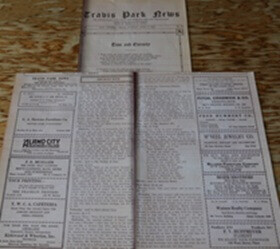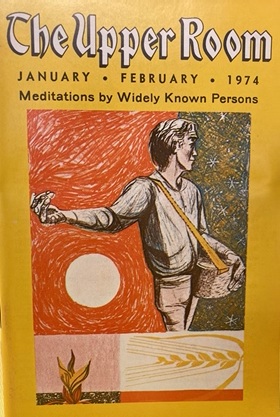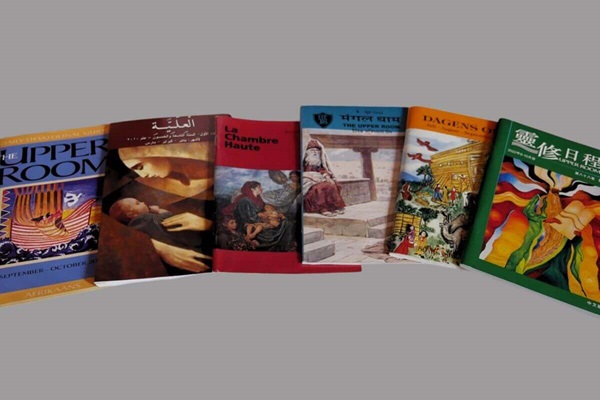One of the longest-running daily devotionals in the world has its roots in Methodism. For 90 years, over 1.5 billion copies of The Upper Room devotional have shared meditations and prayers from 17,000 writers.
“The voices that are writing have expanded, but the content, and the hope for the content, has not changed: That it would be a connection point for Christians around the world, and for it to highlight what unites us in our Christian journey, regardless of denomination or geography,” explains Lindsay Gray, Executive Director for Upper Room editions.
“A pretty beautiful aspect of the daily devotional is the dedication of the readers, that they're willing to regularly send their stories from their own spiritual journeys with the idea that maybe their story could help someone else,” shares the Rev. Jeff Campbell, General Secretary of Discipleship Ministries and interim publisher and Associate General Secretary of The Upper Room. The Upper Room is a ministry of Discipleship Ministries.
Founders of The Upper Room devotional

Frances Craig, a Sunday school teacher at Travis Park Methodist Episcopal Church, urged her pastor, Paul Kern, to write devotionals. Pictured above is an April 6, 1930, newsletter that was an early iteration of The Upper Room. Craig prayed over efforts to launch The Upper Room and was an early contributing writer.
Grover Emmons, a clergyperson who dreamed of a devotional book that would be available and usable for all, worked with the Board of Home Missions in the Methodist Episcopal Church. He was inspired to name the magazine The Upper Room after hearing a sermon about Pentecost.
A timeline of published formats of The Upper Room
1935: The Upper Room debuts in print1938: Spanish edition launches, the longest-running non-English edition
1946: Radio edition begins broadcasting
1958: “Talking books” (LP vinyl records) are launched, which then transition to cassette tapes in the 1970s and CDs in the 1990s
1974: Large print edition debuts
1997: Website and email versions become available
2001: MP3 audio edition is introduced
2016: The Upper Room app is launched for Apple and Android devices
2025: The latest non-English edition, Marathi, launched
Where it all began
The Spirit began moving the original visionaries of The Upper Room in the early 1930s at Travis Park Methodist Episcopal Church in San Antonio, Texas, when people were seeking hope amid the Great Depression. From the beginning, the vision was to reestablish the “family altar” – the practice of daily prayer and Bible reading in the home.
The Methodist church saw the devotional as an ecumenical source of inspiration for the entire Christian Church, and readers responded. In 1935, 100,000 copies of the first issue sold out quickly. Just four years later, each issue saw one million copies printed.
Writers from around the world
People were inspired by the pocket-sized publication and wanted to be a part of it. Readers sent in so many meditations that editors no longer had to invite writers to contribute. This was perhaps due to The Upper Room’s core goal of providing content designed for all followers of Christ, regardless of nationality, age, race or denominational affiliation, to unite them in daily prayer and Scripture reading.
Today, 5,000 reflections are submitted every year, each carefully reviewed by The Upper Room editorial team. With the devotional now available in 100 countries and more than 30 languages, one-third of writers featured in The Upper Room live outside of the U.S.
“As we have added language additions and build up partnerships around the world, we get more and more meditations from various corners of the world,” shares Gray. “We've had submissions from Madagascar and Pakistan, and from Fiji and Macedonia, and all these places where we don't even have specific editions.”
Campbell says, “It's very approachable theology. It's everyday people writing. It's not high-level professors or theologians. It's just the language of the people submitting, which is down-to-earth. And I think that's also why it universally touches people as they read it, because it's easy to understand and from the heart, and that's what makes it powerful.”
A safe place to gather, grow and pray
The Upper Room is also a place set aside from politics or current events. Gray explains that the editorial team has “a real dedication to being a safe space for people from any angle of Christian life…whatever brings you here, this is a safe place to discuss how God is at work in your life and for us to focus on the elements of being a Christ follower that unite us, even when there are remarkable differences.
“It's a moment to be able to step back and say, ‘Wow, this is a context I know nothing about. And yet, how familiar elements of this are, and how similar I am to this person in this other corner of the world.’”
Evolving, yet not
The format of The Upper Room has not changed, as it has always included a daily Scripture reading, personal reflection and prayer. Topics covered in the devotional have changed as the crowdsourced content shifts with the times. It becomes a time capsule of readers’ experiences and faith journeys.
Campbell explains, “It's based on what people are feeling in that particular moment, or what the Spirit is doing in that moment. I think that is why so many people relate to what is written, because it's not just that person. God is working across people's lives.”

The January/February 1974 magazine was a special issue of The Upper Room, featuring meditations from widely known people, such as Jimmy Carter, Johnny Cash, Minnie Pearl, Coretta Scott King, Billy Graham, Lawrence Welk, Dale Evans Rogers and Pat Boone.
What has changed are the ways the devotional is delivered to meet people where they consume content. Campbell just gifted two digital subscriptions to his children, and they often comment on how much the daily reflections resonate with them. He says, “And just to think that that this kind of thing has been happening for 90 years. I’m grateful that it is now helping my kids.”
Technology has also streamlined the writer submission process. “The digital submission portal has allowed us to expand [writer opportunities] very easily, because anybody who has access to the website can share their information,” says Gray.
Daily readers have created a unique digital community. The Upper Room website hosts a prayer wall where people can share their requests and interact with others, as well as an opportunity to comment on recent devotional readings.
As the team looks to the future, they will continue to pray about where the devotional is headed, including an even larger reach around the world, delivery platforms that can be used to reach new readers, and ways people can be even more deeply engaged.
Laura Buchanan works for UMC.org at United Methodist Communications. Contact her by email.
This story was published on August 26, 2025.





